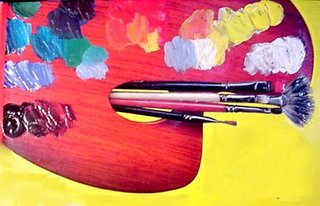
 Bill Guild:perhaps the best teacher I ever had the opportunity to see in action!
Bill Guild:perhaps the best teacher I ever had the opportunity to see in action!In the last few years politicians have learnt from their 'expert' researchers that it is the teacher who is the greatest influence in the classroom and not the curriculums that have dominated everyones thinking the past decades.
It would seem both the researchers and their masters are slow learners because this has been obvious to most parents, teachers and students themselves for many a year. It may be not as obvious though to those teachers who still hold on to the 'myth' that they are all equally important. My experience has taught more that some are more equal than others and a few stand out for their expertise and creativity. Teachers who do 'stand out' have had learnt the trick of not making it too obvious which is a shame - over the years it has been the ideas of such teachers that I have been only to happy to share.
In particular I worked with a group of local teachers many years ago that will forever be part of my image of what teachers should be – and could be if given the right conditions. These teachers had but one abiding desire – it was to help their students develop all the creative talents they had within them. Curriculums were treated with the 'respect' they deserved and the saying of Jerome Bruner that, ‘teaching is the canny art of intellectual temptation’, could have been their philosophy. That is, along with 'networking' with 'like minds'.
All sorts of research now backs up the view of the importance of the teacher and the culture they need to work in. Sadly to many imposed constraints still get in the way of creative teachers, imposed by those who do not trust teachers to do the right the thing given the right support.
In ‘Leading and Making Hope Practical in Schools’ Australians Bob Lingard and Martin Mills identify the power of excellent teachers to see what truly makes the difference in attempt to redress the, so called, imposed ‘idiot proof' solutions. They are careful to state that the teacher variance at best is about 30% but this is more than enough to make a powerful difference, and it is one under every teachers control, unlike the home, peers and even the school and its principal.
Their research found that while teachers have power, a few do damage while others maintain a status quo; their research focused on those having the most powerful effect on achievement (a tricky concept in itself). They identified several dimensions of excellent teachers.
Excellent teachers are able to combine new subject matter with students’ prior knowledge and are able to relate the content to other areas of learning. They are able to 'think on their feet' spontaneously modifying their teaching according to student needs. Their teaching is very context bound and they find it hard to think outside of the specifics of their classroom.
Excellent teachers focus on solving problems with respect to each individuals needs and are opportunistic and flexible in their teaching.
Expert teachers are more adept at anticipating problems continually monitoring students’ responses and improvising accordingly; they are greater seekers and users of feedback.
Their ablility to improvisation makes them better decision makers. Interestingly none of the excellent teachers had written lesson plans but all could describe 'mental plans' for their lessons. They could describe possible sequences but details of timing and pacing were made in response to student questions and concerns. They were very skilful at keeping the lesson 'on track'.
Expert teachers build climates where error is welcomed and where student questioning is high. They are able to deal with the multi –dimensionality of the classrooms by being effective 'scanners' of classroom behaviour; part of their success was their knowledge of what they were teaching and their knowledge of the ability, experience and backgrounds of their students.
They skillfully anticipate disturbances and can detect when students lose interest, or are not understanding. As a result they are better able to seek out and provide feedback enabling them to provide their students with appropriate learning strategies or assistance. They have the skill to do this almost without effort because the skills have become automatic with extensive practice – this is in contrast with ‘novice’ or less expert teachers.
Expert teachers have high respect for all their learners and demonstrate their commitment to them. They can recognize and overcome barriers to learning in their students that others find difficult. Like experts in other domains they show more emotionality about the successes or failures in their work.
All their teaching is focused in developing their students’ responsibility for their own learning and do so by ensuring students are involved in challenging learning tasks that result in both 'mastery' and ‘deep’ learning.Expert teachers achieve ‘deep’ learning rather than superficially . ‘Deep learning’ is where students have created their own understandings, can use what they have learnt, and can relate and connect their knowledge to other areas or tasks.
Rather than ‘do your best’ students are challenged to really engage in their learning and achieve the ‘best they can do’. ‘Learning conversations’ are a feature of their classrooms, focused on sorting out challenging problems students are encountering.
Expert teachers have a positive effect on student outcomes no matter how they are defined – self efficacy, willingness to be challenged, self regulation as well as content.
Without understating the importance of teacher content knowledge (which must be present) the authors believe that is the pedagogical skills, or the ways knowledge is used in the classroom, that 'counts'.
The results, the authors believe, are clear. Expert teachers do differ from experienced teachers particularly in the way they organize their rooms, the degree of challenge and support they present to their students and, most importantly, the depth of processing their students attain. It is less 'how much' students learn but more 'how' they know.
As long as we work on the assumption that all teachers are born equal we will not be able to take advantage of the insights and skills of such teachers.
We still need to provide teachers with resources to assist with content but what will achieve the greatest breakthrough will be a deeper appreciation of the 'artistry' of the excellent teacher.
The task of a school leader is to create the conditions to ensure that the skills of such teachers are distributed throughout the school; creative schools for creative teachers and students.
Such a focus makes ‘hope more practical’ and teaching a more creative and attractive endeavor.












